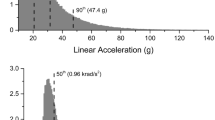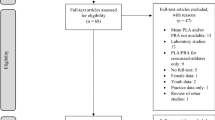Abstract
The relationship between head impact and subsequent brain injury for American football players is not well-defined, especially for youth. The objective of this study is to quantify and assess Head Impact Exposure (HIE) metrics among youth and collegiate football players. This multi-season study enrolled 639 unique athletes (354 collegiate; 285 youth, ages 9–14), recording 476,209 head impacts (367,337 collegiate; 108,872 youth) over 971 sessions (480 collegiate; 491 youth). Youth players experienced 43 and 65% fewer impacts per competition and practice, respectively, and lower impact magnitudes compared to collegiate players (95th percentile peak linear acceleration (PLA, g) competition: 45.6 vs 61.9; 95th percentile PLA practice: 42.6 vs 58.8; 95th percentile peak rotational acceleration (PRA, rad·s−2) competition: 2262 vs 4422; 95th percentile PRA practice: 2081 vs 4052; 95th percentile HITsp competition: 25.4 vs 32.8; 95th percentile HITsp practice: 23.9 vs 30.2). Impacts during competition were more frequent and of greater magnitude than during practice at both levels. Quantified comparisons of head impact frequency and magnitude between youth and collegiate athletes reveal HIE differences as a function of age, and expanded insight better informs the development of age-appropriate guidelines for helmet design, prevention measures, standardized testing, brain injury diagnosis, and recovery management.


Similar content being viewed by others
References
Alosco, M. L., A. B. Kasimis, J. M. Stamm, et al. Age of first exposure to American football and long-term neuropsychiatric and cognitive outcomes. Transl. Psychiatry.7(9):e1236, 2017. https://doi.org/10.1038/tp.2017.197.
Askow, A. T., J. L. Erickson, and A. R. Jagim. Recent trends in youth concussions: a brief report. J. Prim. Care Commun. Health. 11:2150132720985058, 2020. https://doi.org/10.1177/2150132720985058.
Baugh, C. M., and E. Kroshus. Concussion management in US college football: progress and pitfalls. Concussion. 2015. https://doi.org/10.2217/cnc.15.6.
Bellamkonda, S., S. J. Woodward, E. Campolettano, et al. Head impact exposure in practices correlates with exposure in games for youth football players. J. Appl. Biomech. 2018. https://doi.org/10.1123/jab.2017-0207.
Brolinson, P. G., S. Manoogian, D. McNeely, M. Goforth, R. Greenwald, and S. Duma. Analysis of linear head accelerations from collegiate football impacts. Curr. Sports Med. Rep. 5(1):23–28, 2006.
Buzas, D., N. A. Jacobson, and L. G. Morawa. Concussions from 9 youth organized sports: results from NEISS hospitals over an 11-year time frame, 2002–2012. Orthop. J. Sports Med. 2014. https://doi.org/10.1177/2325967114528460.
Buzzini, S. R. R., and K. M. Guskiewicz. Sport-related concussion in the young athlete. Curr. Opin. Pediatr. 18(4):376–382, 2006. https://doi.org/10.1097/01.mop.0000236385.26284.ec.
Campolettano, E. T., R. A. Gellner, E. P. Smith, et al. Development of a concussion risk function for a youth population using head linear and rotational acceleration. Ann. Biomed. Eng. 48(1):92–103, 2020. https://doi.org/10.1007/s10439-019-02382-2.
Campolettano, E. T., S. Rowson, and S. M. Duma. Drill-specific head impact exposure in youth football practice. J. Neurosurg. Pediatr. 18(5):536–541, 2016. https://doi.org/10.3171/2016.5.PEDS1696.
Chu, J. J., J. G. Beckwith, J. J. Crisco, and R. M. Greenwald. A novel algorithm to measure linear and rotational head acceleration using single-axis accelerometers. J. Biomech. 39:S534, 2006. https://doi.org/10.1016/S0021-9290(06)85195-X.
Cobb, B. R., J. E. Urban, E. M. Davenport, et al. Head impact exposure in youth football: elementary school ages 9–12 years and the effect of practice structure. Ann. Biomed. Eng. 41(12):2463–2473, 2013. https://doi.org/10.1007/s10439-013-0867-6.
Council on Sports Medicine And Fitness. Tackling in youth football. Pediatrics. 136(5):e1419–e1430, 2015. https://doi.org/10.1542/peds.2015-3282.
Crisco, J. J., J. J. Chu, and R. M. Greenwald. An algorithm for estimating acceleration magnitude and impact location using multiple nonorthogonal single-axis accelerometers. J. Biomech. Eng. 126(6):849–854, 2004. https://doi.org/10.1115/1.1824135.
Crisco, J. J., R. Fiore, J. G. Beckwith, et al. Frequency and location of head impact exposures in individual collegiate football players. J. Athletic Train. 45(6):549–559, 2010. https://doi.org/10.4085/1062-6050-45.6.549.
Crisco, J. J., B. J. Wilcox, J. G. Beckwith, et al. Head impact exposure in collegiate football players. J Biomech. 44(15):2673–2678, 2011. https://doi.org/10.1016/j.jbiomech.2011.08.003.
Crisco, J. J., B. J. Wilcox, J. T. Machan, et al. Magnitude of head impact exposures in individual collegiate football players. J. Appl. Biomech. 28(2):174–183, 2012. https://doi.org/10.1123/jab.28.2.174.
Daniel, R. W., S. Rowson, and S. M. Duma. Head impact exposure in youth football. Ann. Biomed. Eng. 40(4):976–981, 2012. https://doi.org/10.1007/s10439-012-0530-7.
Duma, S. M., S. J. Manoogian, W. R. Bussone, et al. Analysis of real-time head accelerations in collegiate football players. Clin. J. Sport Med. 15(1):3–8, 2005.
Funk, J. R., S. M. Duma, S. J. Manoogian, and S. Rowson. Biomechanical risk estimates for mild traumatic brain injury. Annu. Proc. Assoc. Adv. Automot. Med. 51:343–361, 2007.
Funk, J. R., S. Rowson, R. W. Daniel, and S. M. Duma. Validation of concussion risk curves for collegiate football players derived from HITS data. Ann. Biomed. Eng. 40(1):79–89, 2012. https://doi.org/10.1007/s10439-011-0400-8.
Gadd, C., Use of a weighted-impulse criterion for estimating injury hazard. SAE. In: 10th Stapp Conference (SAE Paper# 660793): pp. 164–174.
Gennarelli, T. A, Thibault, L. E, Ommaya, A. K., Pathophysiologic Responses to rotational and translational accelerations of the head. In: 1972:296–308. doi:https://doi.org/10.4271/720970
Greenwald, R. M., Gwin, J. T., Chu, J. J., Crisco, J. J., Head impact severity measures for evaluating mild traumatic brain injury risk exposure. Neurosurgery. 2008;62(4):789–798; discussion 798. doi:https://doi.org/10.1227/01.neu.0000318162.67472.ad
Guskiewicz, K. M., and T. C. V. McLeod. Pediatric sports-related concussion. PM&R. 3(4):353–364, 2011. https://doi.org/10.1016/j.pmrj.2010.12.006.
Guskiewicz, K. M., and J. P. Mihalik. Biomechanics of sport concussion: quest for the elusive injury threshold. Exercise Sport Sci. Rev. 39(1):4–11, 2011. https://doi.org/10.1097/JES.0b013e318201f53e.
Harmon, K. G., J. R. Clugston, K. Dec, et al. American Medical Society for Sports Medicine position statement on concussion in sport. Br. J. Sports Med. 53(4):213–225, 2019. https://doi.org/10.1136/bjsports-2018-100338.
Hirst, R. B., A. L. Haas, A. M. Teague, L. T. Whittington, and E. Taylor. Bell ringers: factors related to concussive events in children playing tackle football. J. Pediatr. Health Care. 33(1):14–25, 2019. https://doi.org/10.1016/j.pedhc.2018.05.009.
Hodgson, V. R, Thomas, L. M., Prasad, P., Testing the validity and limitations of the severity index. In: 1970. doi:https://doi.org/10.4271/700901
Kelley, M. E., M. A. Espeland, W. C. Flood, et al. Comparison of head impact exposure in practice drills among multiple youth football teams. J Neurosurg. Pediatr. 23(3):381–389, 2018. https://doi.org/10.3171/2018.9.PEDS18314.
Kerr, Z. Y., C. L. Collins, J. P. Mihalik, S. W. Marshall, K. M. Guskiewicz, and R. D. Comstock. Impact locations and concussion outcomes in high school football player-to-player collisions. Pediatrics. 134(3):489–496, 2014. https://doi.org/10.1542/peds.2014-0770.
King, A. I., Yang, K. H., Zhang, L., Hardy, W., Viano, D. C., Is head injury caused by linear or angular acceleration? Published online 2003:12.
Kirkwood, M. W., K. O. Yeates, and P. E. Wilson. Pediatric sport-related concussion: a review of the clinical management of an oft-neglected population. Pediatrics. 117(4):1359–1371, 2006. https://doi.org/10.1542/peds.2005-0994.
Kontos, A. P., R. J. Elbin, V. C. Fazio-Sumrock, et al. Incidence of sports-related concussion among youth football players aged 8–12 years. J. Pediatr. 163(3):717–720, 2013. https://doi.org/10.1016/j.jpeds.2013.04.011.
Lynall, R. C., K. R. Campbell, E. B. Wasserman, T. P. Dompier, and Z. Y. Kerr. Concussion mechanisms and activities in youth, high school, and college football. J. Neurotrauma. 34(19):2684–2690, 2017. https://doi.org/10.1089/neu.2017.5032.
Manoogian, S., D. McNeely, S. Duma, G. Brolinson, and R. Greenwald. Head acceleration is less than 10 percent of helmet acceleration in football impacts. Biomed. Sci Instrum. 42:383–388, 2006.
McAllister, T., and M. McCrea. Long-term cognitive and neuropsychiatric consequences of repetitive concussion and head-impact exposure. J. Athletic Train. 52(3):309–317, 2017. https://doi.org/10.4085/1062-6050-52.1.14.
McCrea, M., and K. Guskiewicz. Evidence-based management of sport-related concussion. Concussion. 28:112–127, 2014. https://doi.org/10.1159/000358769.
Meaney, D. F., and D. H. Smith. Biomechanics of concussion. Clin. Sports Med. 30(1):19–31, 2011. https://doi.org/10.1016/j.csm.2010.08.009.
Munce, T. A., J. C. Dorman, P. A. Thompson, V. D. Valentine, and M. F. Bergeron. Head impact exposure and neurologic function of youth football players. Med. Sci. Sports Exercise. 47(8):1567–1576, 2015. https://doi.org/10.1249/MSS.0000000000000591.
NCAA Publications. 2020 NCAA football rules and interpretations. Accessed January 14, 2021. https://www.ncaapublications.com/p-4602-2020-ncaa-football-rules-and-interpretations.aspx.
Pellman, E. J., D. C. Viano, A. M. Tucker, and I. R. Casson. Concussion in professional football: location and direction of helmet impacts: part 2. Neurosurgery. 53(6):1328–1341, 2003. https://doi.org/10.1227/01.NEU.0000093499.20604.21.
Pfister, T., K. Pfister, B. Hagel, W. A. Ghali, and P. E. Ronksley. The incidence of concussion in youth sports: a systematic review and meta-analysis. Br. J. Sports Med. 50(5):292–297, 2016. https://doi.org/10.1136/bjsports-2015-094978.
Rowson, S., and S. M. Duma. Brain injury prediction: assessing the combined probability of concussion using linear and rotational head acceleration. Ann. Biomed. Eng. 41(5):873–882, 2013. https://doi.org/10.1007/s10439-012-0731-0.
SAS Institute Inc. Base SAS® 94 Procedures Guide. Cary: SAS Institute Inc, 2013.
Sports-related concussions in youth. improving the science, changing the culture. Mil. Med. 180(2):123–125, 2015. https://doi.org/10.7205/MILMED-D-14-00516.
Stemper, B. D., A. S. Shah, J. Harezlak, et al. Comparison of head impact exposure between concussed football athletes and matched controls: evidence for a possible second mechanism of sport-related concussion. Ann. Biomed. Eng. 47(10):2057–2072, 2019. https://doi.org/10.1007/s10439-018-02136-6.
Stroup, W. W., G. A. Milliken, E. A. Claassen, and R. D. Wolfinger. SAS® for Mixed Models: Introduction and Basic Applications. Cary: SAS Institute Inc., 2018.
Tierney, G. J., C. Kuo, L. Wu, D. Weaving, and D. Camarillo. Analysis of head acceleration events in collegiate-level American football: a combination of qualitative video analysis and in-vivo head kinematic measurement. J. Biomech.110:109969, 2020. https://doi.org/10.1016/j.jbiomech.2020.109969.
USA Football., The football development model. Accessed January 14, 2021. https://fdm.usafootball.com/
Yeargin, S. W., P. Kingsley, J. M. Mensch, J. P. Mihalik, and E. V. Monsma. Anthropometrics and maturity status: a preliminary study of youth football head impact biomechanics. Int. J. Psychophysiol. 132:87–92, 2018.
Young, T. J., R. W. Daniel, S. Rowson, and S. M. Duma. Head impact exposure in youth football: elementary school ages 7–8 years and the effect of returning players. Clin. J. Sport Med. 24(5):416–421, 2014. https://doi.org/10.1097/JSM.0000000000000055.
Acknowledgments
This project is possible thanks to the previous efforts of Dr. Stephen Duma and his team at Virginia Tech, Dr. Joel Stitzel and his team at Wake Forest University, Dr. Rick Greenwald and his team at Simbex, and all those involved throughout the years from the Crisco Lab.
Funding
Research reported in this publication was supported by the National Institutes of Health under Award Numbers NIH R01NS094410, R01HD048638, and RO1NS055020.
Conflict of interest
HIT System technology was developed in part under NIH R44HD40743 and research and development support from Riddell Inc (Elyria, OH). J.G.B., R.M.G., and J.J.C. have a financial interest in the instruments (HIT System, Sideline Response System; Riddell Inc) that were used to collect the biomechanical data reported in this study.
Author information
Authors and Affiliations
Corresponding author
Additional information
Associate Editor Stefan M.Duma oversaw the review of this article.
Publisher's Note
Springer Nature remains neutral with regard to jurisdictional claims in published maps and institutional affiliations.
Supplementary Information
Below is the link to the electronic supplementary material.
Rights and permissions
About this article
Cite this article
Choi, G.B., Smith, E.P., Duma, S.M. et al. Head Impact Exposure in Youth and Collegiate American Football. Ann Biomed Eng 50, 1488–1497 (2022). https://doi.org/10.1007/s10439-022-02974-5
Received:
Accepted:
Published:
Issue Date:
DOI: https://doi.org/10.1007/s10439-022-02974-5




